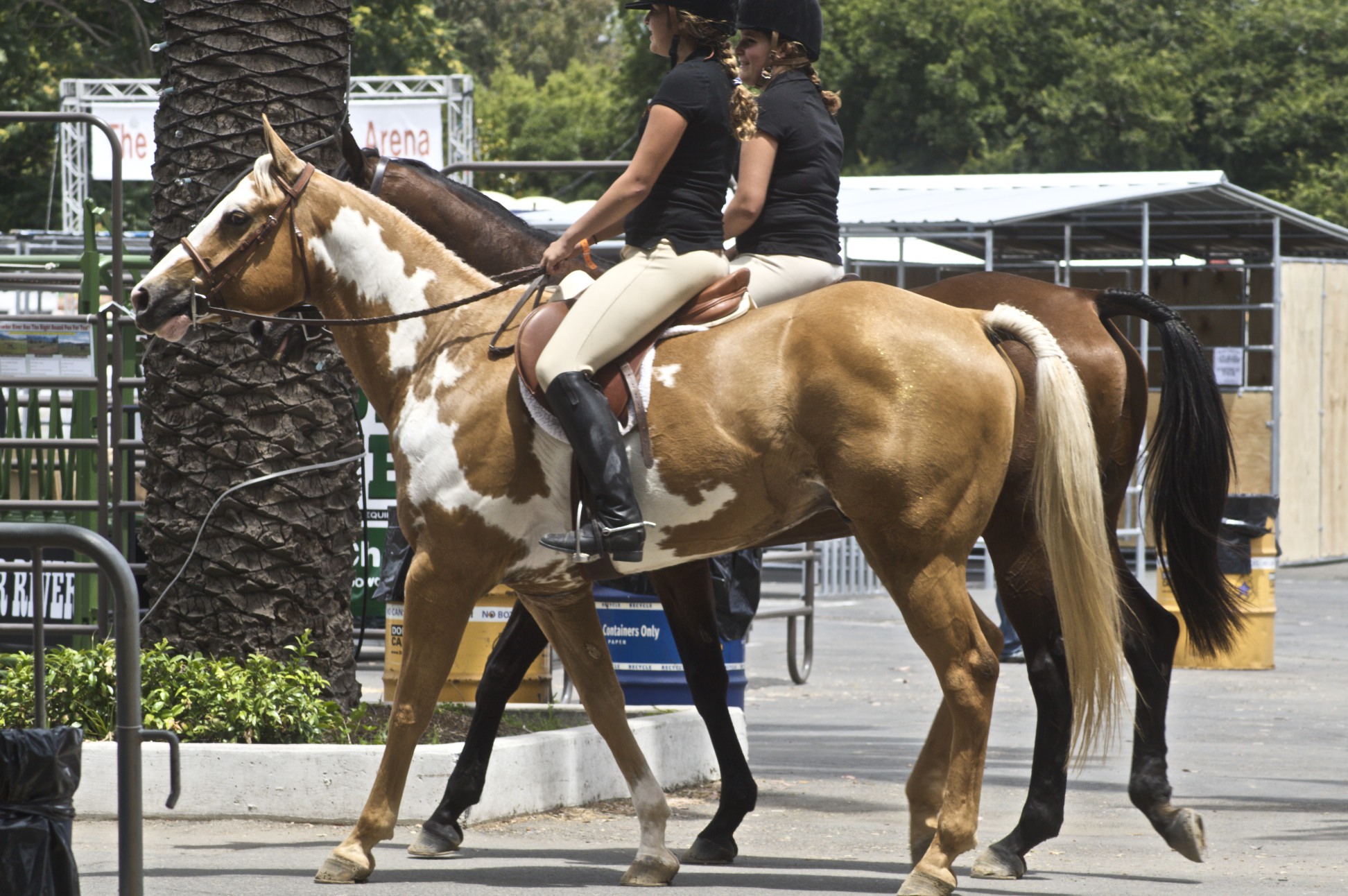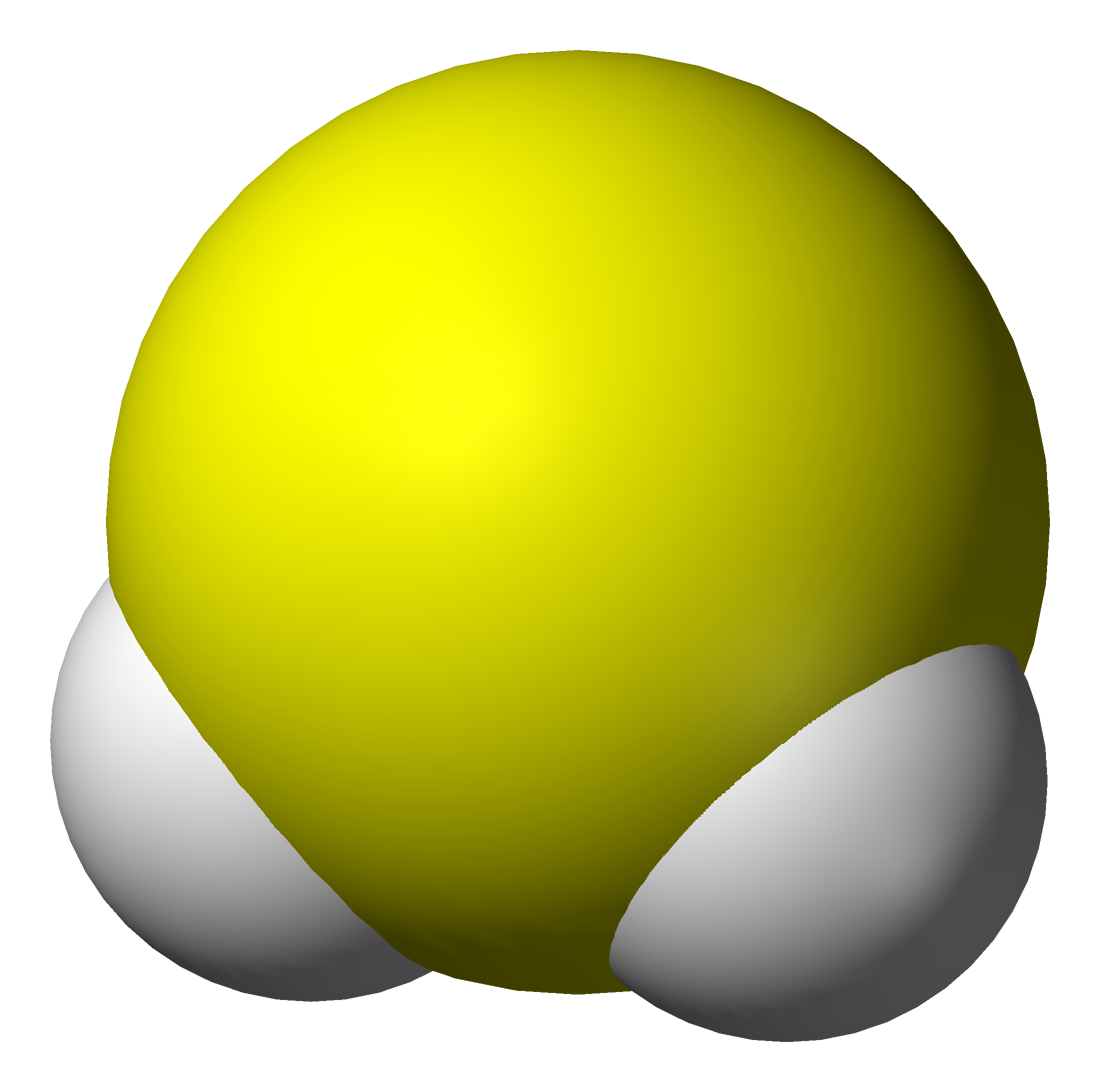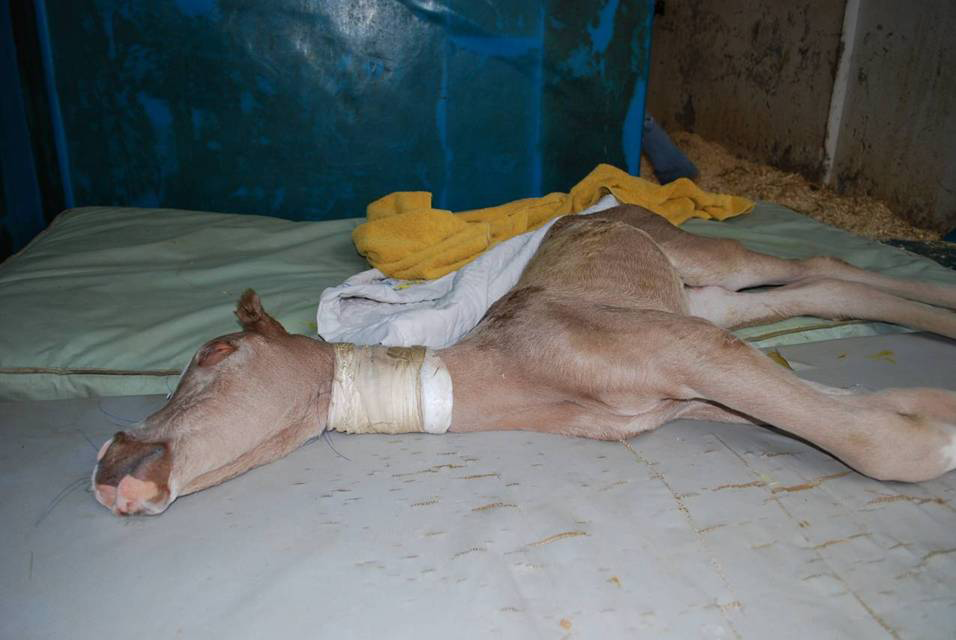|
Lethal White Syndrome
Lethal white syndrome (LWS), also called overo lethal white syndrome (OLWS), lethal white overo (LWO), and overo lethal white foal syndrome (OLWFS), is an autosomal genetic disorder most prevalent in the American Paint Horse. Affected foals are born after the full 11-month gestation and externally appear normal, though they have all-white or nearly all-white coats and blue eyes. However, internally, these foals have a nonfunctioning colon. Within a few hours, signs of colic appear; affected foals die within a few days. Because the death is often painful, such foals are often humanely euthanized once identified. The disease is particularly devastating because foals are born seemingly healthy after being carried to full term. The disease has a similar cause to Hirschsprung's disease in humans. A mutation in the middle of the endothelin receptor type B (''EDNRB'') gene causes lethal white syndrome when homozygous. Carriers, which are heterozygous—that is, have one copy of th ... [...More Info...] [...Related Items...] OR: [Wikipedia] [Google] [Baidu] |
Overo
Overo refers to several genetically unrelated pinto coloration patterns of white-over-dark body markings in horses, and is a term used by the American Paint Horse Association to classify a set of pinto patterns that are not tobiano. ''Overo'' is a Spanish word, originally meaning "like an egg".''American Paint Horse Association's Guide to Coat Color Genetics'' American Paint Horse Association, 2007. Accessed August 19, 2008 The most common usage refers to frame overo, but and [...More Info...] [...Related Items...] OR: [Wikipedia] [Google] [Baidu] |
Allele
An allele is a variant of the sequence of nucleotides at a particular location, or Locus (genetics), locus, on a DNA molecule. Alleles can differ at a single position through Single-nucleotide polymorphism, single nucleotide polymorphisms (SNP), but they can also have insertions and deletions of up to several thousand base pairs. Most alleles observed result in little or no change in the function or amount of the gene product(s) they code or regulate for. However, sometimes different alleles can result in different observable phenotypic traits, such as different pigmentation. A notable example of this is Gregor Mendel's discovery that the white and purple flower colors in pea plants were the result of a single gene with two alleles. Nearly all multicellular organisms have two sets of chromosomes at some point in their biological life cycle; that is, they are diploid. For a given locus, if the two chromosomes contain the same allele, they, and the organism, are homozygous with re ... [...More Info...] [...Related Items...] OR: [Wikipedia] [Google] [Baidu] |
Rectum
The rectum (: rectums or recta) is the final straight portion of the large intestine in humans and some other mammals, and the gut in others. Before expulsion through the anus or cloaca, the rectum stores the feces temporarily. The adult human rectum is about long, and begins at the rectosigmoid junction (the end of the sigmoid colon) at the level of the third sacral vertebra or the sacral promontory depending upon what definition is used. Its diameter is similar to that of the sigmoid colon at its commencement, but it is dilated near its termination, forming the rectal ampulla. It terminates at the level of the anorectal ring (the level of the puborectalis sling) or the dentate line, again depending upon which definition is used. In humans, the rectum is followed by the anal canal, which is about long, before the gastrointestinal tract terminates at the anal verge. The word rectum comes from the Latin '' rēctum intestīnum'', meaning ''straight intestine''. Struc ... [...More Info...] [...Related Items...] OR: [Wikipedia] [Google] [Baidu] |
Cecum
The cecum ( caecum, ; plural ceca or caeca, ) is a pouch within the peritoneum that is considered to be the beginning of the large intestine. It is typically located on the right side of the body (the same side of the body as the appendix (anatomy), appendix, to which it is joined). The term stems from the Latin ''wikt:caecus, caecus'', meaning "blindness, blind". It receives chyme from the ileum, and connects to the ascending colon of the large intestine. It is separated from the ileum by the ileocecal valve (ICV), also called Bauhin's valve. It is also separated from the Large intestine#Structure, colon by the cecocolic junction. While the cecum is usually intraperitoneal, the ascending colon is Retroperitoneal space, retroperitoneal. In herbivores, the cecum stores food material where bacteria are able to break down the cellulose. In humans, the cecum is involved in absorption of Salt (chemistry), salts and Electrolyte, electrolytes and lubricates the solid waste that pas ... [...More Info...] [...Related Items...] OR: [Wikipedia] [Google] [Baidu] |
Equine Anatomy
Equine anatomy encompasses the gross and microscopic anatomy of horses, ponies and other equids, including donkeys, mules and zebras. While all anatomical features of equids are described in the same terms as for other animals by the International Committee on Veterinary Gross Anatomical Nomenclature in the book '' Nomina Anatomica Veterinaria'', there are many horse-specific colloquial terms used by equestrians. External anatomy * Back: the area where the saddle sits, beginning at the end of the withers, extending to the last thoracic vertebrae (colloquially includes the loin or "coupling", though technically incorrect usage) * Barrel: the body of the horse, enclosing the rib cage and the major internal organs * Buttock: the part of the hindquarters behind the thighs and below the root of the tail * Cannon or cannon bone: the area between the knee or hock and the fetlock joint, sometimes called the "shin" of the horse, though technically it is the third metacarpal * Chestnu ... [...More Info...] [...Related Items...] OR: [Wikipedia] [Google] [Baidu] |
Enema
An enema, also known as a clyster, is the rectal administration of a fluid by injection into the Large intestine, lower bowel via the anus.Cullingworth, ''A Manual of Nursing, Medical and Surgical'':155 The word ''enema'' can also refer to the liquid injected, as well as to a device for administering such an injection. In standard medicine, the most frequent uses of enemas are to relieve constipation and for bowel cleansing before a medical examination or procedure; also, they are employed as a lower gastrointestinal series (also called a barium enema), to treat Travelers' diarrhea, traveler's diarrhea, as a vehicle for the administration of food, water or medicine, as a stimulant to the general system, as a local application and, more rarely, as a means of reducing body temperature, as treatment for encopresis, and as a form of Management of dehydration, rehydration therapy (proctoclysis) in patients for whom intravenous therapy is not applicable. Medical usage The princip ... [...More Info...] [...Related Items...] OR: [Wikipedia] [Google] [Baidu] |
Feces
Feces (also known as faeces American and British English spelling differences#ae and oe, or fæces; : faex) are the solid or semi-solid remains of food that was not digested in the small intestine, and has been broken down by bacteria in the large intestine. Feces contain a relatively small amount of metabolic waste products such as bacterially-altered bilirubin and dead epithelial cells from the lining of the gut. Feces are discharged through the anus or cloaca during defecation. Feces can be used as fertilizer or soil conditioner in agriculture. They can also be burned as dry animal dung fuel, fuel or dried and used for wattle and daub, construction. Some medicinal uses have been found. In the case of human feces, fecal transplants or fecal bacteriotherapy are in use. Urine and feces together are called excretion, excreta. Characteristics The distinctive odor of feces is due to skatole, and thiols (sulfur-containing compounds), as well as amines and carboxylic acids. Sk ... [...More Info...] [...Related Items...] OR: [Wikipedia] [Google] [Baidu] |
Meconium
Meconium is the earliest stool of a mammalian infant resulting from defecation. Unlike later feces, meconium is composed of materials ingested during the time the infant spends in the uterus: intestinal epithelial cells, lanugo, mucus, amniotic fluid, bile, and water. Meconium, unlike later feces, is viscous and sticky like tar – its color usually being a very dark olive green and it is almost odorless. When diluted in amniotic fluid, it may appear in various shades of green, brown, or yellow. It should be completely passed by the end of the first few days after birth, with the stools progressing toward yellow (digested milk). Clinical significance Meconium in amniotic fluid Meconium is normally retained in the infant's bowel until after birth, but sometimes it is expelled into the amniotic fluid prior to birth or during labor and delivery. The stained amniotic fluid is recognized by medical staff as a possible sign of fetal distress. Some post-dates pregnancies ... [...More Info...] [...Related Items...] OR: [Wikipedia] [Google] [Baidu] |
Lavender Foal Syndrome
Lavender foal syndrome (LFS), also called coat color dilution lethal (CCDL), is an autosomal recessive genetic disease that affects newborn foals of certain Arabian horse bloodlines. Affected LFS foals have severe neurological abnormalities, cannot stand, and require euthanasia shortly after birth. The popular name originates due to a diluted color of the foal's coat, that in some cases appears to have a purple or lavender hue. However, not all foals possess the lavender coat colour, and colouring can range from silver to light chestnut to a pale pink. Carrier horses have no clinical signs and DNA testing can determine if a horse carries the gene. Impacted bloodlines Arabians of "Egyptian" bloodlines have the most documented cases of the disorder, with 10.3% of Egyptian Arabians being carriers, but only 1.8% of non-Egyptian Arabians. Cases reported in peer-reviewed veterinary literature are mostly of foals descended from a number of "Egyptian Arabian" or Egyptian-related bloodlin ... [...More Info...] [...Related Items...] OR: [Wikipedia] [Google] [Baidu] |
Tobiano
Tobiano is a spotted color pattern commonly seen in pinto horses, produced by a dominant gene. The tobiano gene produces white-haired, pink-skinned patches on a base coat color. The coloration is almost always present from birth and does not change throughout the horse's lifetime, unless the horse also carries the gray gene. It is a dominant gene, so any tobiano horse must have at least one parent who carries the tobiano gene. Other spotting patterns seen in pinto horses include frame overo, splashed white and sabino. In the United Kingdom, tobianos are frequently referred to as "coloured" or as "pied": piebald if black and white, skewbald if white and any base color other than black. Sometimes "painted" is also used. Bay and white tobiano horses are also referred to as tricoloured. Characteristics Tobiano traits generally include the following: * White legs from the hocks and knees down * White crossing the back between the withers and the dock of the tail * Whit ... [...More Info...] [...Related Items...] OR: [Wikipedia] [Google] [Baidu] |
Overo
Overo refers to several genetically unrelated pinto coloration patterns of white-over-dark body markings in horses, and is a term used by the American Paint Horse Association to classify a set of pinto patterns that are not tobiano. ''Overo'' is a Spanish word, originally meaning "like an egg".''American Paint Horse Association's Guide to Coat Color Genetics'' American Paint Horse Association, 2007. Accessed August 19, 2008 The most common usage refers to frame overo, but and [...More Info...] [...Related Items...] OR: [Wikipedia] [Google] [Baidu] |
Genetic Testing
Genetic testing, also known as DNA testing, is used to identify changes in DNA sequence or chromosome structure. Genetic testing can also include measuring the results of genetic changes, such as RNA analysis as an output of gene expression, or through biochemical analysis to measure specific protein output. In a medical setting, genetic testing can be used to diagnose or rule out suspected genetic disorders, predict risks for specific conditions, or gain information that can be used to customize medical treatments based on an individual's genetic makeup. Genetic testing can also be used to determine biological relatives, such as a child's biological parentage (genetic mother and father) through DNA paternity testing, or be used to broadly predict an individual's ancestry. Genetic testing of plants and animals can be used for similar reasons as in humans (e.g. to assess relatedness/ancestry or predict/diagnose genetic disorders), to gain information used for selective breed ... [...More Info...] [...Related Items...] OR: [Wikipedia] [Google] [Baidu] |







